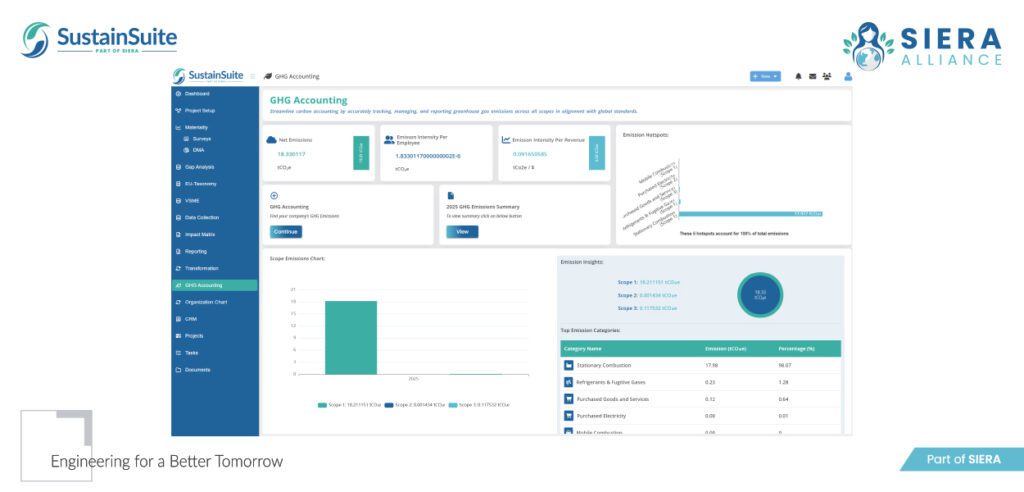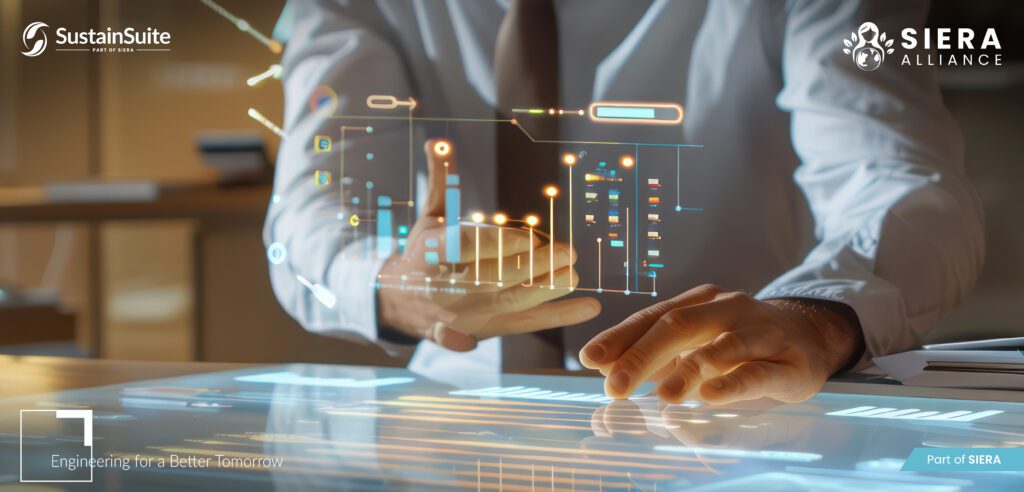Turning ESG Complexity into Actionable Insights
In today’s evolving ESG landscape, organizations face a common challenge: how to translate complex frameworks like the CSRD and ESRS into measurable, auditable, and actionable processes. SustainSuite offers a solution that bridges the gap between regulatory compliance and strategic sustainability—empowering companies to operationalize ESG materiality with confidence.
The Challenge: Fragmented Data and Manual Reporting
Over 40% of companies still struggle with fragmented ESG data. Environmental metrics live in one spreadsheet, HR indicators in another, and governance disclosures in yet another. This siloed approach leads to inconsistent results, manual errors, and reactive decision-making.
Similarly, limited stakeholder engagement undermines credibility—only 32% of companies systematically involve their stakeholders in materiality assessments. The result? Missed insights, compliance risks, and diminished investor trust.
The SustainSuite Solution: Unified, Transparent, and Intelligent
SustainSuite – Part of SIERA brings efficiency, transparency, and scalability to ESG management through an integrated digital platform that unifies all key processes—from data collection to disclosure.
Here’s how each module simplifies the ESG journey:
| Challenge | SustainSuite Module | Outcome |
| Fragmented ESG Data | Integrated ESG Data Hub | Centralizes metrics into one system, ensuring consistency and auditability. |
| Limited Stakeholder Engagement | Stakeholder Survey Module | Enables structured, inclusive engagement with investors, employees, and communities. |
| Lack of Transparency | Value Chain Mapping | Connects ESG topics with real-world impacts across the supply chain. |
| Complex Double Materiality | DMA (Double Materiality Assessment) | Digitizes both impact and financial materiality assessments per CSRD and ESRS. |
| Time-Intensive Reporting | Automated Reporting Integration | Generates ESRS-compliant reports instantly, reducing manual work. |
Operationalizing Double Materiality
Double Materiality sits at the heart of ESG compliance. SustainSuite’s DMA Module guides users step-by-step through stakeholder mapping, topic selection, and survey-based assessments—automatically generating weighted matrices and impact scores. The platform translates CSRD requirements into clear workflows, allowing companies to trace every decision and data source for full audit readiness.
Driving Stakeholder Trust Through Engagement
SustainSuite’s Stakeholder Engagement Module transforms one-way consultation into measurable dialogue. Users can design tailored surveys, segment stakeholders by category, and analyze real-time feedback through dashboards and visual analytics. Every input is logged as verifiable evidence—strengthening transparency and trust while aligning with ESRS stakeholder inclusion mandates.
Mapping Impact Across the Value Chain
With SustainSuite’s Value Chain Mapping, organizations can identify where ESG impacts occur—upstream with suppliers, within operations, or downstream with customers. This module links each stage of activity with environmental and social indicators, providing a full picture of risks and opportunities across the business ecosystem.
Automation for Audit-Ready Reporting
Manual ESG reporting is resource-heavy and error-prone. SustainSuite’s automation engine connects assessment data directly to ESRS disclosure fields, ensuring that every metric and narrative aligns with regulatory requirements. Companies can visualize their reporting progress, fill data gaps, and generate export-ready, audit-compliant reports in minutes.
From Compliance to Strategic Advantage
By uniting data, people, and processes into one intelligent platform, SustainSuite turns ESG compliance into a strategic business enabler. Organizations benefit from:
- Reduced reporting time and costs
- Real-time insights and dashboards
- Improved investor and stakeholder confidence
- Enhanced access to green finance opportunities
With SustainSuite, sustainability becomes a driver of performance, not paperwork.
Ready to move from ESG complexity to clarity?
Explore how SustainSuite – part of SIERA can streamline your CSRD compliance and ESG reporting today.
👉 Visit SustainSuite to request a demo and learn how we help organizations operationalize sustainability—efficiently, transparently, and impactfully.





